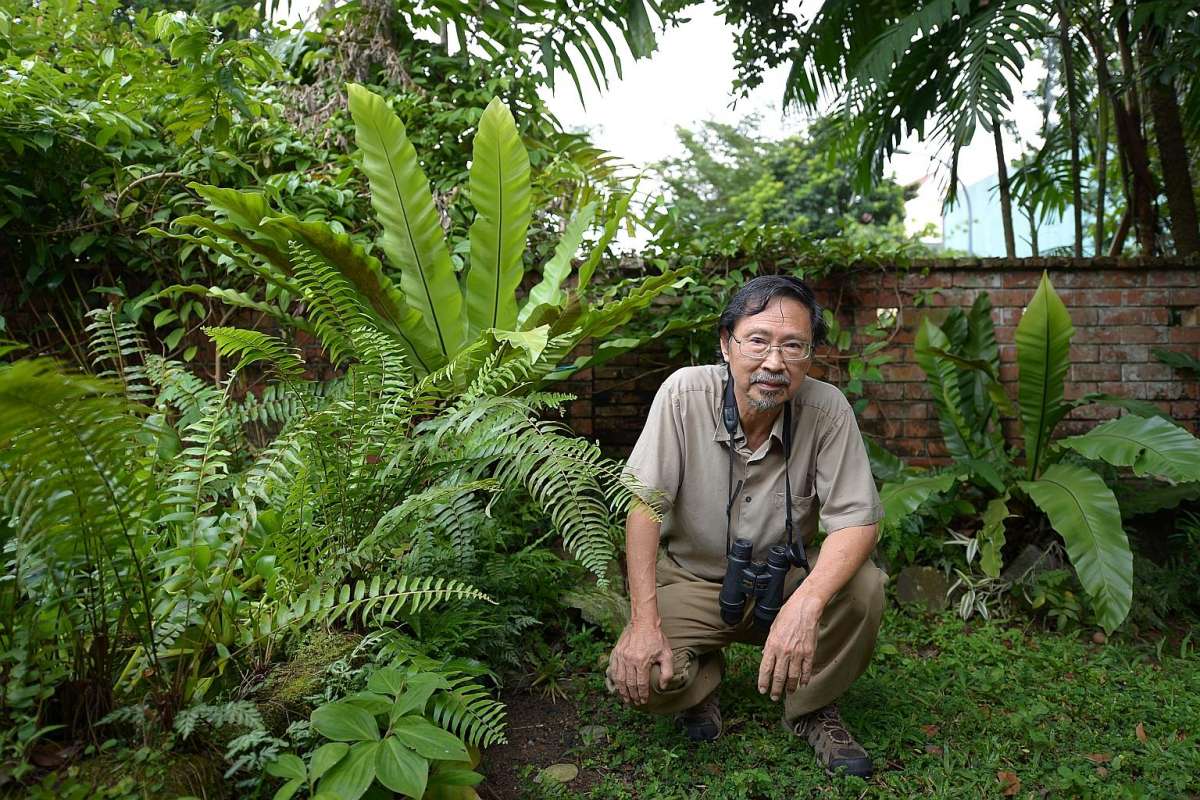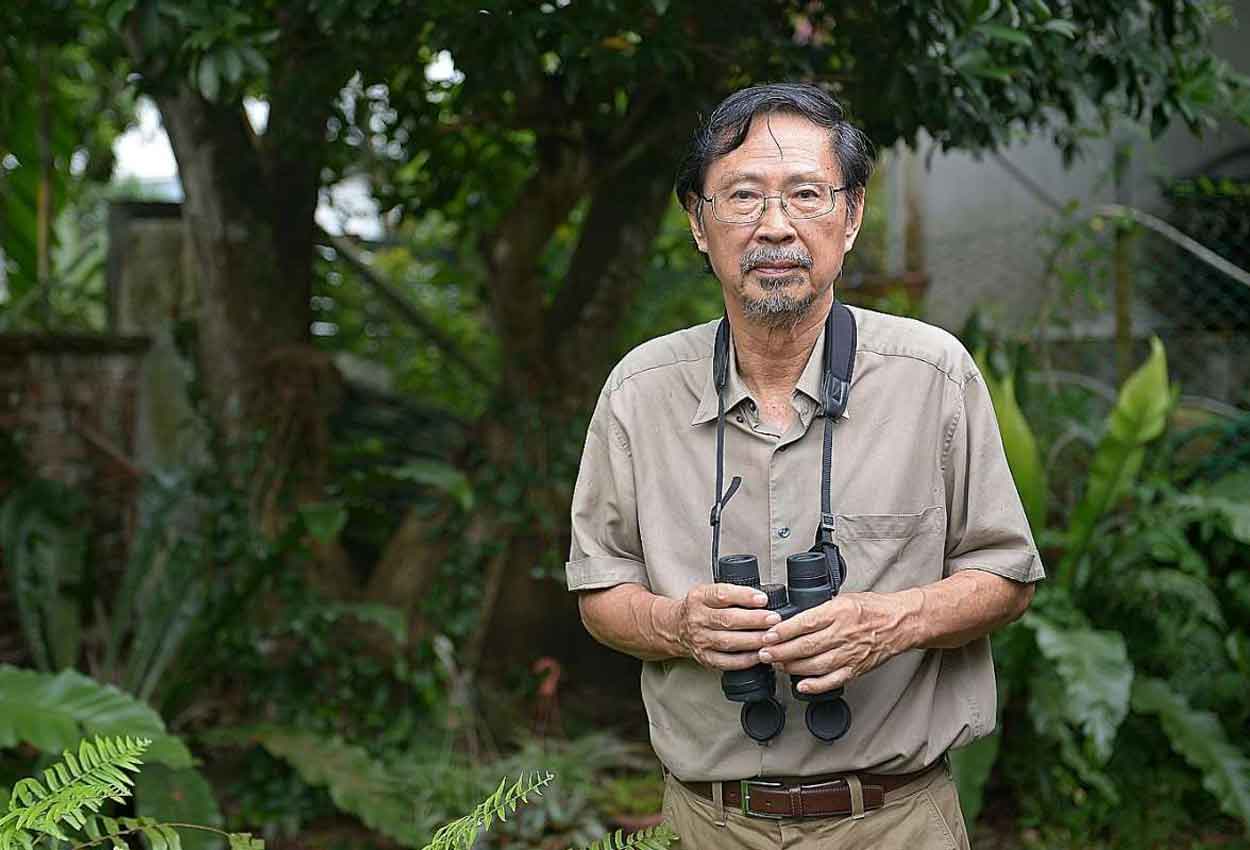A few monkeys bound across the roof of conservationist Ho Hua Chew’s house. These long-tailed macaques have come from the forest in the Central Catchment Nature Reserve, which lies behind his detached single-storey house in the Upper Thomson area.
Dr Ho, 70, and his wife bought their property in the 1980s because they wanted to be close to the wilderness in Singapore. They do not mind that creatures from the woods periodically spill over into their space. Once, an endangered slow loris found shelter in the sprawling bohemia plant on their garden wall.
This proximity to nature is more than literal; it reflects what Dr Ho calls a love of the land, an ethos that has sustained the former philosophy lecturer’s conservation work. Over decades, he and the Nature Society (Singapore), where he serves as the vice-chairman of the conservation committee, have engaged with the authorities in a bid to curb the tide of development in Singapore and retain bio-diverse pockets of the wild.
Almost 30 years ago, he led the Nature Society (Singapore) in its efforts to conserve the bird haven Sungei Buloh, which was slated for redevelopment. It was the first time a civil society group successfully lobbied the government to change its plans.
His life’s work earned him the “Outstanding Advocate of Our Time” accolade, the first award of its kind, at the Singapore Advocacy Awards last month.
Veteran activist Constance Singam, chair of civil society activist group The Working Committee 3 (TWC3), which organised the awards, says: “It takes a very long time to change attitudes. Dr Ho has been raising awareness about conservation for about 40 years. He has won the respect of both civil society and policymakers.”
The award was created just for Dr Ho, says Mrs Singam, adding that his advocacy was rare when he became active in the 1980s, a period of intense urbanisation in a political climate that was “difficult” for civil society. She credits him with paving the way for other groups and movements, such as the voices raised against the planned development of the historic Bukit Brown cemetery in recent years, which concerned issues of both conservation and heritage.
Dr Ho, who quit full-time work in 1999 to dedicate his time to conservation work, could be said to have a lofty idealism. But a bureaucrat’s pragmatism shines through him as well.
With competing needs in population-dense Singapore, such as housing and infrastructure, the battle for conservation is sometimes lost. “We fight for 100 per cent; we’re lucky if we get 20 per cent,” says Dr Ho, who joined the nature society in 1971.
The seeds of this belief were planted in a free-roaming childhood spent exploring forests and longkangs (Malay for drains).
He was born in Kuala Lumpur, the third of five children. His late father Ho Toon Seng relocated his young family to Singapore when he found employment as a cook with a British family. Dr Ho has few memories of his mother, who died of illness when he was in primary school.
They lived in the servants’ quarters in a colonial bungalow in Dalvey Estate, surrounded by woods and fields. He used to fling away his schoolbag after school and dash out, together with the gardener’s son and his younger brother, Wah Loong, to explore the area.
It was the 1950s then, and the children caught spiders and climbed trees to pick rambutans. He saw cattle being herded along Bukit Timah Road, followed by flocks of egrets scrambling to devour the insects stirred by the cows. He caught a soft-shelled turtle in a longkang, the site of fishing expeditions. When he tried to take it home, it bit him and he was forced to release it.
“I would say my love of nature began and evolved from my childhood,” says Dr Ho.
During the 1960s, he found national service training tough under the supervision of Israeli advisers, but marching in remote, rural areas intensified his fascination with the beauty of the Singapore countryside.
While pursuing postgraduate studies at the University of Washington with his wife, Dr Khoo Kim Choo, in the 1970s, he took up birdwatching, later joining fellow hobbyists in the Bird Group in Nature Society (Singapore) in the mid-1980s, which conducted surveys and research on bird species in Singapore.

An agnostic, he was drawn to the study of philosophy as it pondered the meaning of life. Apart from his studies for his philosophy doctorate in Washington, he read the classic nature writings of 19th-century authors such as American Aldo Leopold, who wrote about the love of the land and wilderness.
After his childhood view of exploring nature as a great adventure, Dr Ho embraced this perspective. Now a Singapore citizen, he describes it as a kind of patriotism.
“If you love nature, you’ll love your land. This is your country. You love the beauty of the wildlife. Wildlife also deserves a place in the sun,” he says.
He took two Master’s degrees, in conservation and ecology, in Britain, to learn more about the “scientific and technical” aspects of these subjects, to aid his conservation work.
Back in Singapore, he was part of a group of birdwatchers from the Nature Society (Singapore) who initiated a proposal in December 1987 to create a nature reserve in birdlife-rich Sungei Buloh, which was originally designated by the Government for agrotechnology development.
The late president Wee Kim Wee was among the officials who visited the wetland, which officially opened in 1993 as the Sungei Buloh Nature Park. It was gazetted as a nature reserve on Jan 1, 2002.
The success of Sungei Buloh made Dr Ho feel “bold”, he recalls.
Then came subsequent challenges.
In the 1990s, the government rejected an appeal, backed by 25,000 Singaporeans and coordinated by Dr Ho, to conserve 70ha of land in Senoko as a nature park.
It was the last of a series of bids to save the bird habitat in Sembawang after initial efforts to conserve all 168ha was turned down in 1994 because that would have meant a loss of 17,000 housing units.
Dr Ho recalls it was a “big blow” after spearheading the appeal and working with others to garner signatures from the public everywhere, from parks to shopping centres.
The Senoko decision played a role in his resignation from his job as a lecturer at the Department of Philosophy at National University of Singapore in 1999. He had been working at NUS since the early 1970s and has since earned what he calls “pocket money” teaching ad hoc courses in environmental and conservation issues at NUS and other tertiary institutions.
He felt he had to choose between philosophy and conservation.
“It was urgent. There was a lot of development in the 1980s and 1990s. I had to make a choice. (After Senoko) I thought, well, we have to work harder. Maybe I was a bit naive, but I have no regrets. Life became more meaningful.”
His wife was supportive in becoming the family’s main breadwinner. Dr Khoo, 69, is the founder of Preschool for Multiple Intelligences and a consultant for early childhood development.
She says: “We’re both doing the work we love to do, but he doesn’t get paid for it.”
She describes her husband of more than 40 years as intense and determined. Besides his work, she recalls how Dr Ho, an avid reader, once took a road trip from Seattle, across the United States to the country’s east coast to check out second-hand bookshops for his library of more than 3,000 second-hand books.
The couple have one son, Hee Juan, an IT engineer in his 40s who is married with two sons and lives in Melbourne, Australia.
Since 1999, Dr Ho has been doing conservation work full-time on behalf of the Nature Society (Singapore), which he describes as a supportive family.
Since the early 1990s, with fellow volunteers, he has been coordinating and writing detailed reports and proposals for the conservation of wildlife-supporting areas including Marina South, Kranji Marshes, Khatib Bongsu, South Simpang, Kent Ridge and Sentosa.
Coming up with surveys, monitoring wildlife and meeting with officials can be challenging, he says. The process can take decades. For example, the society’s proposal to conserve the Kranji Marshes was first mooted in 1990 and the area opened to the public as the largest freshwater marshland in Singapore earlier this year. It is home to 54 species of butterflies and more than 170 species of birds, including the critically endangered straw-headed bulbul.
Dr Ho points to challenges along the way over some 25 years for the Kranji Marshes and its environs, such as the building of a transmission station and a golf course.
A frequent letter-writer to The Straits Times’ Forum about conservation issues, he has spent sleepless nights worrying about the impact of the letters he writes, explaining the stand of Nature Society (Singapore).
It used to be tense in the early decades of his work when he met with government officials, he says, declining to be specific.
“I wasn’t scared because I believe that what I’m doing is not political. It’s something neutral. But we are affected by the tension,” he says.
People warned him that if he did something that contradicted the Government’s plans, there might be consequences. But he has not experienced anything adverse.
“Things are better now. Officials are getting more open, more friendly,” he says, adding that concerns such as climate change have come to the forefront as well, in recent years.
Mr N. Sivasothi, 50, a biological sciences lecturer at NUS, says Dr Ho’s detailed research and polite approach have paid off and inspired younger conservationists like himself. “He has a very gentlemanly demeanour about him, (yet) he is persistent. He tries to argue using information and people respond to a passionate speaker,” says Mr Sivasothi.
For his part, while Dr Ho is encouraged that young people have been taking up causes such as the preservation of Bukit Brown, he feels that more focus should be given to less known areas that are unprotected, such as the biodiversity in the Tagore area.
Since stepping down as conservation committee chairman of the Nature Society (Singapore) about seven years ago, he still does research and reports.
He is modest about his accomplishments.
“I don’t have a talent for administration. We’re amateurs. We fumble, we struggle… I concentrate on the birdlife. If you believe in a cause, that nature has value, you just push on.”

This article was first published on Sep 12, 2016.
Get a copy of The Straits Times or go to straitstimes.com for more stories.






